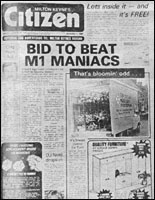![]()
The contents on this page remain on our website for informational purposes only.
Content on this page will not be reviewed or updated.
 |
|
 |
|
|
||||
|
Bletchley Gazette
|
||||
|
||||
|
|
||||
|
Milton Keynes Citizen February 9, 2012
Time travel. Now there’s a conundrum. And not least the old chestnut of how could you exist if you travelled back in time and did away with your grandfather before he had a chance to procreate. Personally, I think this approach is quite wrong. All you need to do is reconstitute the exact states of matter that existed at a particular time and you would have the past in the present without altering the future. And before the men in white coats arrive, how, I hear you ask, would you know what these states of matter were, and their ongoing sequence? Umm, well I’m still working on this, but, in a gross over simplification, perhaps equating the Big Bang to a break of billiard balls comes to mind. By fundamental laws their path and position can be predicted at any point and so someday perhaps the same will be possible for particles of matter, on a Universal scale. Anyway, I’m just off for a lie down, before beginning this week’s piece on a less fanciful means of time travel - reading through the archives of the local newspapers, and more specifically the Bletchley Gazette. During December 1930, Mr. Harold Price came to Bletchley to look at a small amount of printing equipment that, having belonged to the deceased Mr. Tuckey, was being offered at an ‘absurdly cheap’ price in a building (not for sale) that many years later would become the Dudeney and Johnston store. At the time Mr. and Mrs. Price owned a small print business in the Oxfordshire village of Steeple Aston and while Mr. Price purchased and arranged the storage of the equipment, his wife continued the established business. The couple then decided to settle in Bletchley and having purchased 87, Bletchley Road (now Queensway) in a field at the bottom of the back garden Mr. Price built a timber and asbestos printing shed. Born in Oxfordshire of a ‘numerous family’ he had joined the Army at the age of 16½ but was invalided out due to the effects of a gas attack. Lacking any specific skills he then returned to civilian life and while being employed as an auxiliary postman he learnt the print trade with a country printer. In Bletchley, as a junior stationery salesman Mr. E. Staniford had often visited Mr. Price for orders and he one day suggested that there seemed a need in the town for a local newspaper. This met with an enthusiastic response and their first office was in a tackling shed in Mr. Price’s back garden, with the actual printing undertaken by the Bedfordshire Times Publishing Co. Despite being busy with his printing business Mr. Price wrote the lead articles and the children’s column whilst Mr. Staniford produced the rest. However, soon the printing costs of the Bedfordshire Times proved too expensive and so they decided to acquire an ‘intertype’ printing machine and a flat bed machine. As these were too expensive to purchase new they travelled to the headquarters of Intertype and persuaded the managing director to sell them a new machine, with payment over four years. They then went to a firm in London which had advertised a flat bed machine for sale and this they purchased for £250, to be spread over two years. Thus in June 1934, the first Bletchley Gazette to be printed and published in Bletchley appeared and they now took on a full time operator, working in a derelict shed next to Mr. Price’s home. Despite a fire in May 1948 the paper flourished and with the relaxation of wartime constraints could expand and from January 1949 sell as many copies as it could. Expansion of the town by the London overspill brought additional readers and in the late 1960s the offices moved from Queensway to Ward Road, Mount Farm. Then came the New City and in September 1974 the name was changed to the Milton Keynes Gazette. This was a time of new printing technology but the proprietors refused to embrace the methods and in 1981 came the challenge from the more forward thinking Citizen. In 1985 the proprietors then closed the Ward Road premises but under new ownership the paper was produced from the spring of 1986 in small offices in Aylesbury Street, until circumstances forced a final closure in 1993. |
||||
|
|
||||
|
|
||||


